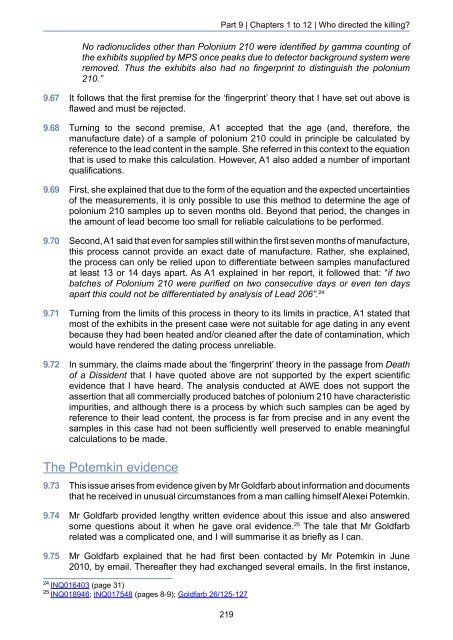The Litvinenko Inquiry
JIEp7Zyr
JIEp7Zyr
Create successful ePaper yourself
Turn your PDF publications into a flip-book with our unique Google optimized e-Paper software.
Part 9 | Chapters 1 to 12 | Who directed the killing?<br />
No radionuclides other than Polonium 210 were identified by gamma counting of<br />
the exhibits supplied by MPS once peaks due to detector background system were<br />
removed. Thus the exhibits also had no fingerprint to distinguish the polonium<br />
210.”<br />
9.67 It follows that the first premise for the ‘fingerprint’ theory that I have set out above is<br />
flawed and must be rejected.<br />
9.68 Turning to the second premise, A1 accepted that the age (and, therefore, the<br />
manufacture date) of a sample of polonium 210 could in principle be calculated by<br />
reference to the lead content in the sample. She referred in this context to the equation<br />
that is used to make this calculation. However, A1 also added a number of important<br />
qualifications.<br />
9.69 First, she explained that due to the form of the equation and the expected uncertainties<br />
of the measurements, it is only possible to use this method to determine the age of<br />
polonium 210 samples up to seven months old. Beyond that period, the changes in<br />
the amount of lead become too small for reliable calculations to be performed.<br />
9.70 Second, A1 said that even for samples still within the first seven months of manufacture,<br />
this process cannot provide an exact date of manufacture. Rather, she explained,<br />
the process can only be relied upon to differentiate between samples manufactured<br />
at least 13 or 14 days apart. As A1 explained in her report, it followed that: “if two<br />
batches of Polonium 210 were purified on two consecutive days or even ten days<br />
apart this could not be differentiated by analysis of Lead 206”. 24<br />
9.71 Turning from the limits of this process in theory to its limits in practice, A1 stated that<br />
most of the exhibits in the present case were not suitable for age dating in any event<br />
because they had been heated and/or cleaned after the date of contamination, which<br />
would have rendered the dating process unreliable.<br />
9.72 In summary, the claims made about the ‘fingerprint’ theory in the passage from Death<br />
of a Dissident that I have quoted above are not supported by the expert scientific<br />
evidence that I have heard. <strong>The</strong> analysis conducted at AWE does not support the<br />
assertion that all commercially produced batches of polonium 210 have characteristic<br />
impurities, and although there is a process by which such samples can be aged by<br />
reference to their lead content, the process is far from precise and in any event the<br />
samples in this case had not been sufficiently well preserved to enable meaningful<br />
calculations to be made.<br />
<strong>The</strong> Potemkin evidence<br />
9.73 This issue arises from evidence given by Mr Goldfarb about information and documents<br />
that he received in unusual circumstances from a man calling himself Alexei Potemkin.<br />
9.74 Mr Goldfarb provided lengthy written evidence about this issue and also answered<br />
some questions about it when he gave oral evidence. 25 <strong>The</strong> tale that Mr Goldfarb<br />
related was a complicated one, and I will summarise it as briefly as I can.<br />
9.75 Mr Goldfarb explained that he had first been contacted by Mr Potemkin in June<br />
2010, by email. <strong>The</strong>reafter they had exchanged several emails. In the first instance,<br />
24<br />
INQ016403 (page 31)<br />
25<br />
INQ018946; INQ017548 (pages 8-9); Goldfarb 26/125-127<br />
219


